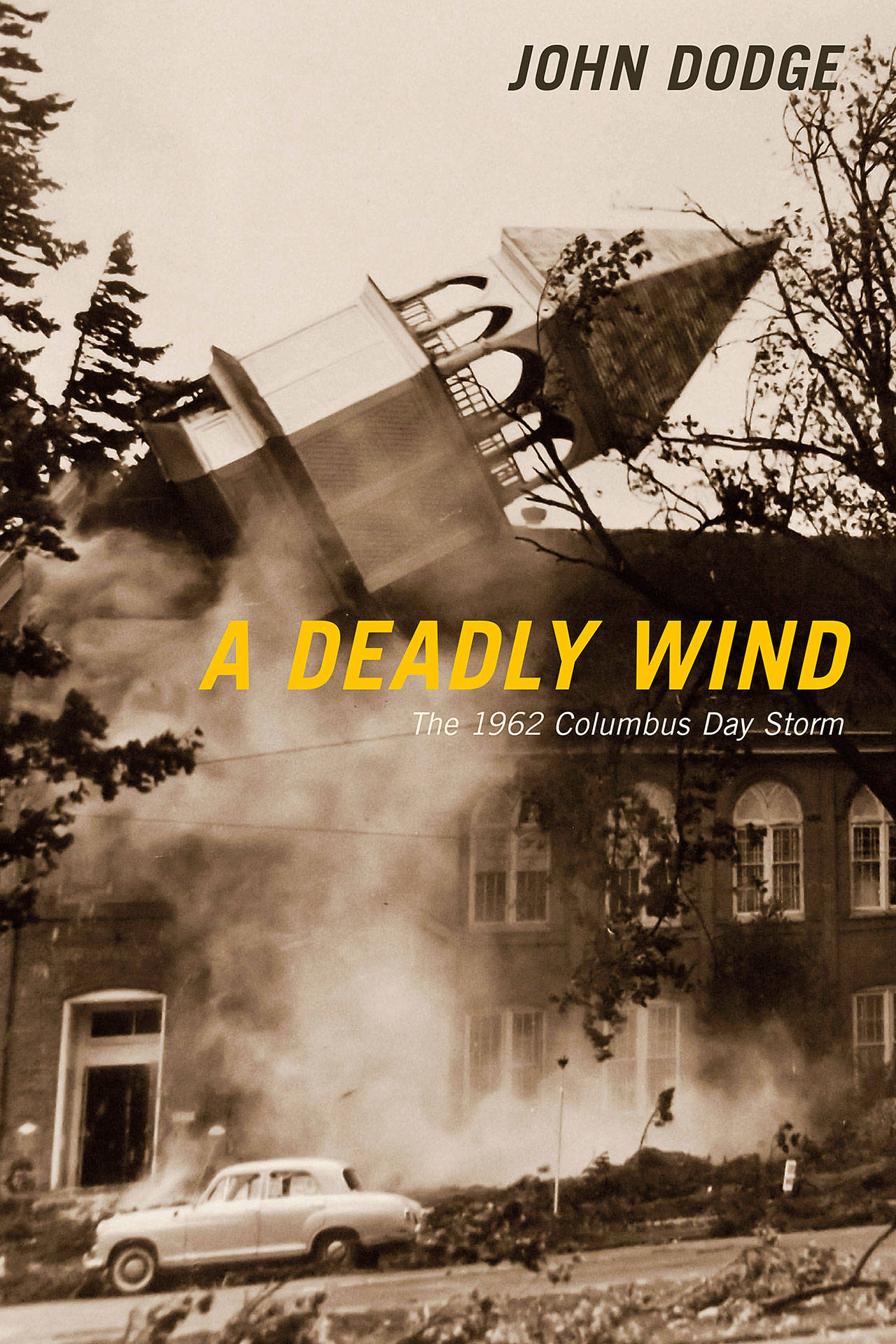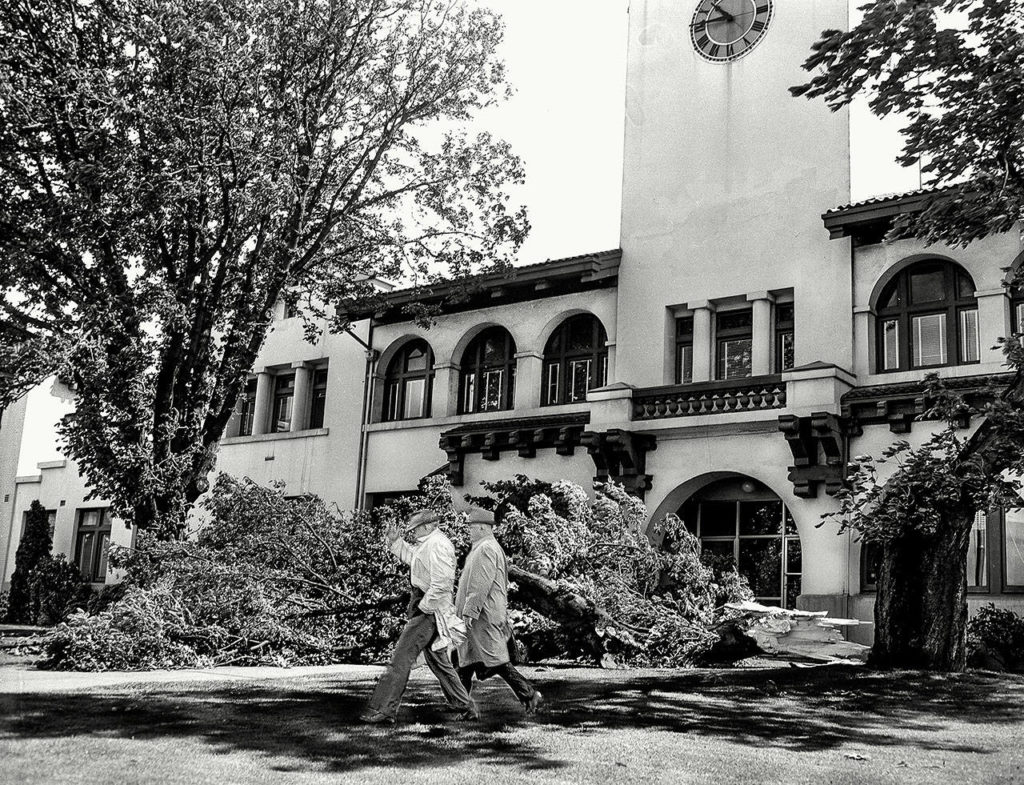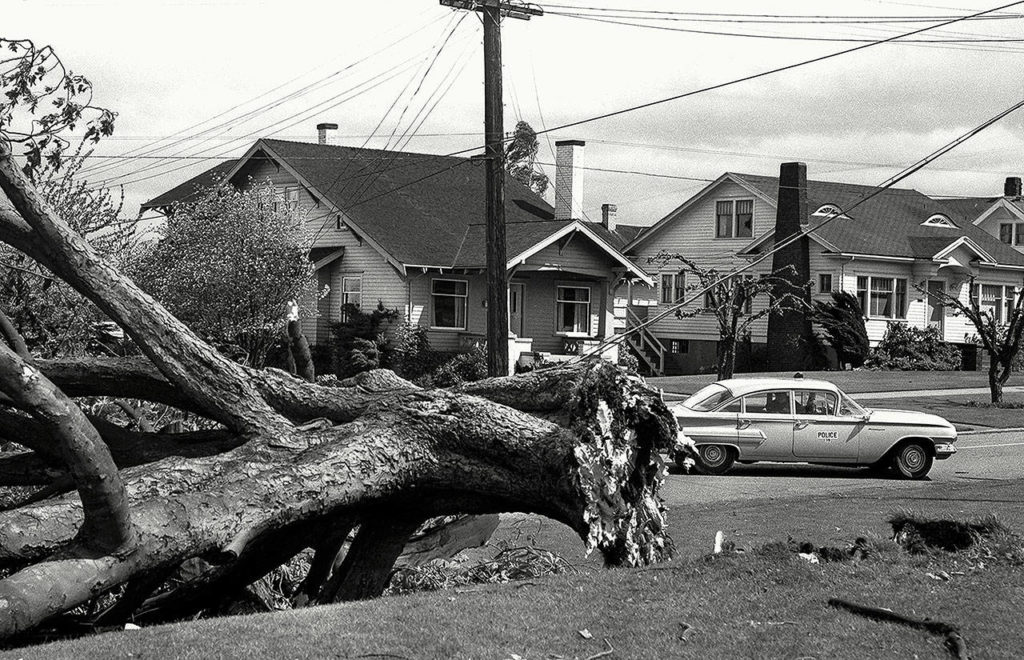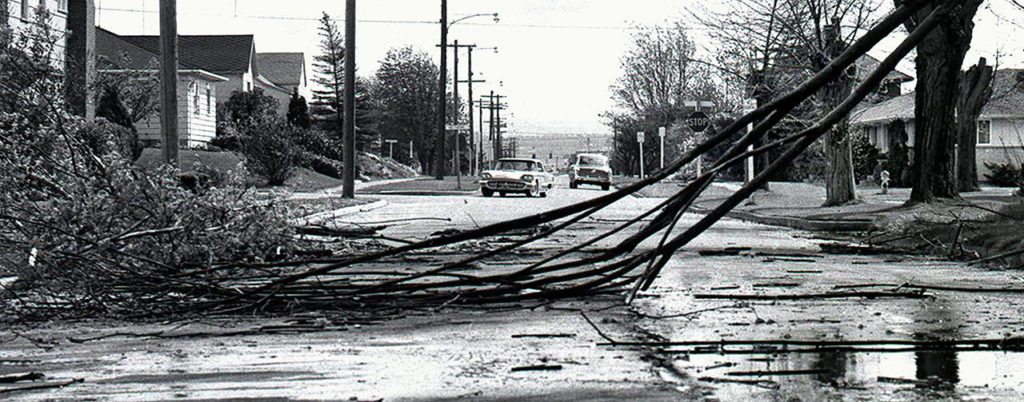John Dodge was 14 on Oct. 12, 1962. It was a Friday, like this year. He was at a high school football game when a state trooper came onto the field with a megaphone. The crowd was told to leave and take shelter. A big storm was about to hit.
A journalist retired from The Olympian newspaper, Dodge lived in Lacey then. His parents thought they’d be safer at a friend’s house, not in their rural home surrounded by woods.
“So we got to this house and were huddled in the family room. And a 60-year-old Douglas fir crashed down on the house,” Dodge said Thursday. “Nobody was hurt, but it was quite memorable.”
A picture of that massive tree atop a house is on page 135 of Dodge’s book, “A Deadly Wind: The 1962 Columbus Day Storm,” published this month by Oregon State University Press.
This is the 56th anniversary of the monster storm, which began in the Pacific as Typhoon Freda. As it walloped the coast, Northern California to British Columbia, it killed 46 people. Victims included a man killed near Sultan.
According to data compiled by Wolf Read, for the “Storm King” website of the Office of Washington State Climatologist at the University of Washington, here are some peak gusts recorded that day: Everett’s Paine Field, 81 mph; Vancouver, Washington, 92 mph; Bellingham, 98 mph; Portland International Airport, 104 mph; Portland’s Morrison Bridge, 116 mph; Corvallis, Oregon, 127 mph; and Newport, Oregon, 138 mph.
At San Francisco’s Candlestick Park, the storm postponed game six of the World Series.
“Giant Storm Leaves Trail of Death and Destruction,” said The Everett Herald’s front-page headline on Oct. 13, 1962. The Herald reported that Jack Wilson, 28, was working on a diversion tunnel at the Sultan River Dam when a tree fell into the construction area, killing him.
Shattered glass is Ronee Grannis Anderson’s strongest memory of that day. Now 70, the Arlington-area woman was a ninth-grader at Everett’s North Junior High. She had hoped to go to the Everett High football game that night, but her dad said no. Her parents were helping at a Hawthorne Elementary School carnival. Anderson was home with her younger brother, Terry, and a friend.
Suddenly there was “just a crash,” she said Wednesday. The front window blew out — or rather, blew into the house. “My brother had been sitting on the couch in front of the window, but he had gotten up,” she said.
Whidbey Island’s Sue Ellen White grew up in Portland. She was in high school when the storm slammed the city.
White, 73, remembers driving home from a friend’s house. “Power poles were leaning and swaying back and forth,” said White, who lives in Clinton. “It felt like the ground was moving. I had an old Buick, a very sturdy car, but I didn’t know what to do. There were trees falling all over the place. Power lines were whipping up and down between the poles.”
After making it home, she and her parents worried about her brother, a student at Portland State University. “He was taking the bus. Nobody had cellphones then,” she said. They were all safe, but White said it took days before the power came back.
In 2012, White and Anderson were featured in Gale Fiege’s extensive 50th anniversary Herald article about the Columbus Day Storm.
It took the region by surprise. That wouldn’t happen today, said Mike McFarland, a meteorologist with the National Weather Service in Seattle. In 1962, “the science was in its infancy,” he said. “It’s difficult to be surprised now. We’re more likely to have a few false alarms.”
It was 1960 when TIROS-1, the first successful low-earth orbital weather satellite, was launched. “We’re now in a completely different world, with multiple weather satellites taking imagery,” McFarland said. Pictures can be updated every minute, he said.
Before satellites, there were reports from ships in the Pacific, but they were infrequent. Now, along with satellite images, computer models used in forecasting get “more accurate every year,” McFarland said.
In “A Deadly Wind,” Dodge wrote that he was spurred into the book project after reading Cliff Mass’s weather blog just after the storm’s 50th anniversary. A University of Washington atmospheric sciences professor, Mass wrote in 2012 that the Columbus Day disaster was “the most powerful and destructive storm to strike the Northwest since the arrival of European settlers” and was far stronger than the 1991 “Perfect Storm” of film fame.
Looking at the storm after a half-century, Dodge discovered fascinating consequences.
In a chapter titled “Fallen Forests,” he wrote that the storm jump-started log exports to Japan. And “The Wind and Wine” chapter tells how the Dundee Hills of Oregon’s Willamette Valley became known for pinot noir production after the storm took down nut and fruit trees that would take years to regrow.
Dodge, who had also worked at The Daily World in Aberdeen, was racing the clock to tell many of the book’s stories.
He spoke with Dr. Dean Brooks, who in 1962 was superintendent of the Oregon State Hospital, just days before he died. Brooks, who appeared as a psychiatrist in the movie “One Flew Over the Cuckoo’s Nest,” lived in Everett later in his life. He died in 2013 at a care facility in Salem, Oregon.
“I started to develop a sense of urgency to get the project done,” Dodge said. “A lot of my subjects were in their 80s and 90s.”
Julie Muhlstein: 425-339-3460; jmuhlstein@heraldnet.com.
Talk to us
> Give us your news tips.
> Send us a letter to the editor.
> More Herald contact information.




























